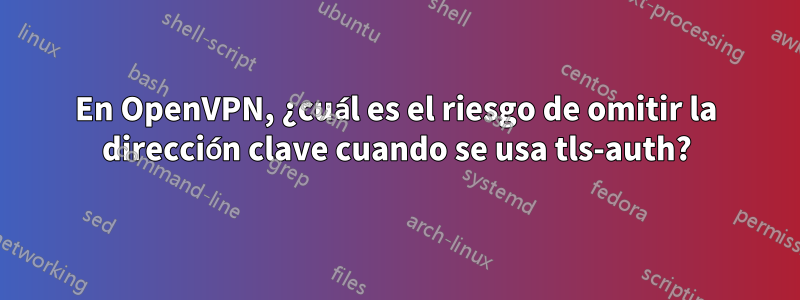
En mi configuración OpenVPN habilitada para TLS, me gustaría utilizar la seguridad adicional que ofrece el uso de tls-auth. La buena noticia es que funciona como se esperaba. Sin embargo, tengo una pregunta sobre el key-directionparámetro opcional (ya sea como segundo parámetro de la tls-authopción o como key-directionopción).
El parámetro de configuración se describe en la página de manual de la siguiente manera (versión 2.3.x, fragmentos relevantes):
--tls-auth file [direction]
Add an additional layer of HMAC authentication on top of the TLS control
channel to protect against DoS attacks.
In a nutshell, --tls-auth enables a kind of "HMAC firewall" on OpenVPN's
TCP/UDP port, where TLS control channel packets bearing an incorrect HMAC
signature can be dropped immediately without response.
file (required) is a key file which can be in one of two formats:
(1) An OpenVPN static key file generated by --genkey (required if direc‐
tion parameter is used).
(2) A freeform passphrase file. In this case the HMAC key will be derived
by taking a secure hash of this file, similar to the md5sum(1) or
sha1sum(1) commands.
OpenVPN will first try format (1), and if the file fails to parse as a
static key file, format (2) will be used.
See the --secret option for more information on the optional direction
parameter.
... (snip)
--secret file [direction]
Enable Static Key encryption mode (non-TLS). Use pre-shared secret file
which was generated with --genkey.
The optional direction parameter enables the use of 4 distinct keys (HMAC-
send, cipher-encrypt, HMAC-receive, cipher-decrypt), so that each data
flow direction has a different set of HMAC and cipher keys. This has a
number of desirable security properties including eliminating certain
kinds of DoS and message replay attacks.
When the direction parameter is omitted, 2 keys are used bidirectionally,
one for HMAC and the other for encryption/decryption.
The direction parameter should always be complementary on either side of
the connection, i.e. one side should use "0" and the other should use "1",
or both sides should omit it altogether.
The direction parameter requires that file contains a 2048 bit key. While
pre-1.5 versions of OpenVPN generate 1024 bit key files, any version of
OpenVPN which supports the direction parameter, will also support 2048 bit
key file generation using the --genkey option.
... (snip)
--key-direction
Alternative way of specifying the optional direction parameter for the
--tls-auth and --secret options. Useful when using inline files (See sec‐
tion on inline files).
Tenga en cuenta que no estoy usando el modo de cifrado de clave estática, sino que solo muestro el --secretfragmento de la página de manual porque lo sugiere la --tls-authdescripción.
No entiendo las explicaciones aquí. ¿Se mejora la seguridad al especificar una dirección (0 para servidor, 1 para cliente) o no si se omite?
Respuesta1
(Esta respuesta es específica para el uso de key-direction para claves tls-auth. Para el modo de clave estática, por favorsiempreuse la dirección clave.)
La ventaja de utilizar diferentes claves para cada dirección es que los paquetes que se originan en un par nunca pueden ser reproducidos hacia ese par por un atacante intermediario. Por supuesto, los protocolos TLS y OpenVPN subyacentes.deberíaNunca acepte dichos paquetes, pero el objetivo de tls-auth es ofrecer (alguna) protección contra errores en el protocolo o la implementación que causan que los mecanismos subyacentes fallen.


